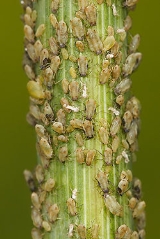
Aphid
Overview
Aphids, also known as plant lice and in Britain and the Commonwealth as greenflies, blackflies or whiteflies, (not to be confused with "jumping plant lice
" or true whiteflies
) are small sap sucking insect
s, and members of the superfamily
Aphidoidea. Aphids are among the most destructive insect pests on cultivated plants in temperate regions. The damage they do to plants has made them enemies of farmers and gardeners the world over, but from a zoological standpoint they are a very successful group of organisms. Their success is in part due to the asexual reproduction
capability of some species.
About 4,400 species of 10 families are known.
Jumping plant louse
Psyllids or jumping plant lice are small plant-feeding insects that tend to be very host specific, i.e. they only feed on one plant species or feed on a few related plants...
" or true whiteflies
Whitefly
The whiteflies, comprising only the family Aleyrodidae, are small hemipterans. More than 1550 species have been described. Whiteflies typically feed on the underside of plant leaves.-Agricultural threat:...
) are small sap sucking insect
Insect
Insects are a class of living creatures within the arthropods that have a chitinous exoskeleton, a three-part body , three pairs of jointed legs, compound eyes, and two antennae...
s, and members of the superfamily
Taxonomic rank
In biological classification, rank is the level in a taxonomic hierarchy. Examples of taxonomic ranks are species, genus, family, and class. Each rank subsumes under it a number of less general categories...
Aphidoidea. Aphids are among the most destructive insect pests on cultivated plants in temperate regions. The damage they do to plants has made them enemies of farmers and gardeners the world over, but from a zoological standpoint they are a very successful group of organisms. Their success is in part due to the asexual reproduction
Asexual reproduction
Asexual reproduction is a mode of reproduction by which offspring arise from a single parent, and inherit the genes of that parent only, it is reproduction which does not involve meiosis, ploidy reduction, or fertilization. A more stringent definition is agamogenesis which is reproduction without...
capability of some species.
About 4,400 species of 10 families are known.
Unanswered Questions

